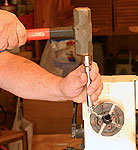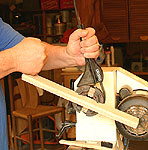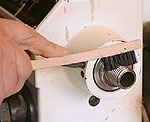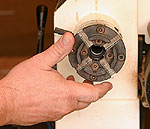This is a Veteran Owned site
| |
Hammers not allowed - or needed Text & Photos by Tom Hintz If you turn wood, you own, or will own, a chuck. Modern lathe chucks, like the Oneway Talon 4-jaw scroll chuck in the accompanying photos, are well made and easy to use. However, there is one problem nearly everyone encounters sooner or later with a chuck regardless of brand – getting it off the lathe. No Hammers! I have heard from too many new (and veteran) turners who have damaged their chuck or lathe by using a hammer to break the chuck free. Aside from marring or distorting the chuck, the impacts of hammer blows can chip or even break the bearings supporting the spindle. Get a Strap Wrench There is a ready-made tool for this task called a strap wrench. A heavy fabric-reinforced rubber belt is secured to a handle on one end. The remainder of the belt wraps around the chuck before threading back into the handle. When pressure is applied, the belt is locked in place and handles length provides a substantial amount of leverage that multiplies the force being applied. Grip, Pull and Maybe ThumpTo free a stubborn chuck, lock the spindle according to the lathe manufacturers instructions. Wrap the strap wrench around the body of the chuck and snug up the strap. Remember that strap wrenches are directional so it has to be wrapped around the chuck in the correct direction. It is also good to know that when the chuck breaks free, it does so all at once. Depending on where the hand pulling on the wrench is aimed, you can deliver an embarrassing blow to your own nose, as did a NewWoodworker.com viewer, nearly knocking himself out. Install the strap wrench so when locked on the belt the handle is at the 10 o'clock position. That way the pulling pressure is downward, not at your face. Installing the ChuckFirst, clean the threads on the spindle and inside the chuck thoroughly. Debris trapped in either place can act like thread-locking compound and make the chuck difficult to seat or remove later. Turn the chuck onto the spindle being careful not to cross thread it. The chuck should thread onto the spindle easily without a lot of play or tightness. Turn the chuck by hand until it contacts the shoulder on the spindle (or bottoms out) and then back it off ½ to ¾ of a turn. Using just your hand and a snap of the wrist, spin the chuck clockwise and let it "bump" into the shoulder. This should be all that is needed to lock the chuck onto the spindle. Everything you do when using the chuck tends to tighten it more. Woodturning lathes and chucks are expensive making it well worth your time to treat them right. Installing and removing the lathe chuck need not be a damaging experience, or a frustrating one. Take your time, follow the procedure described here and your chuck, and you, will remain undamaged. |
Do you have a comment about this page? - Email Me! |
All written, photographic and drawn materials are property of and copyright by NewWoodworker.com LLC 2000-2019. Materials may not be used in any way without the written permission of the owner.





